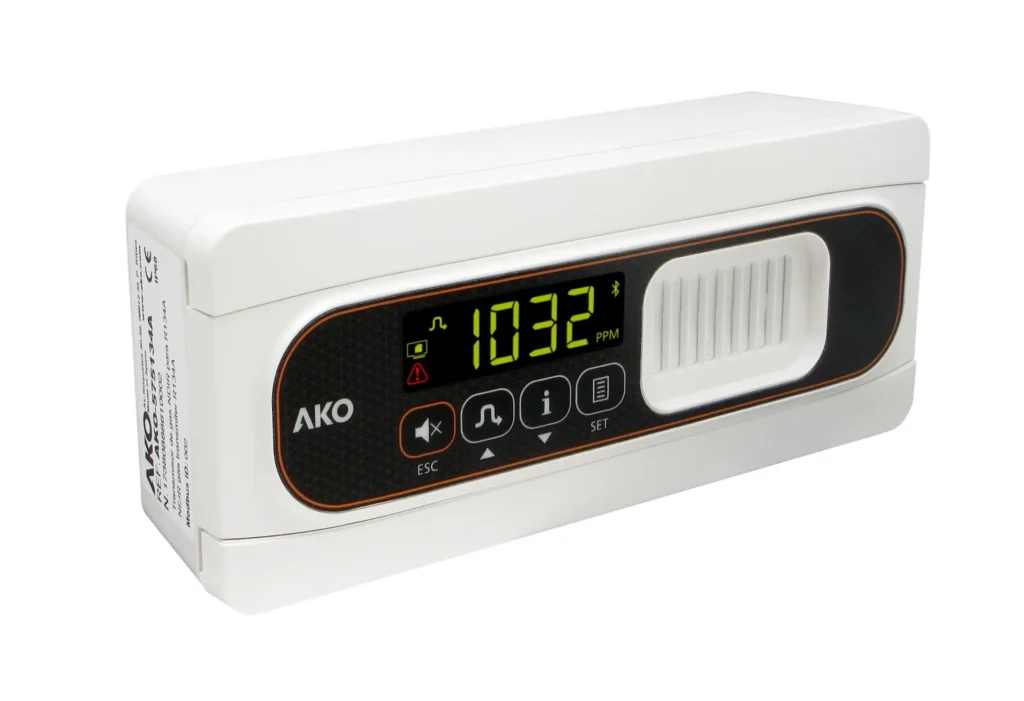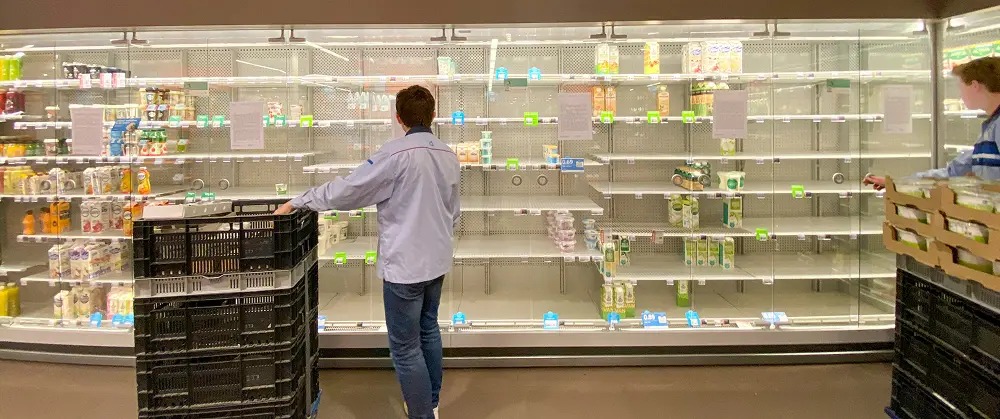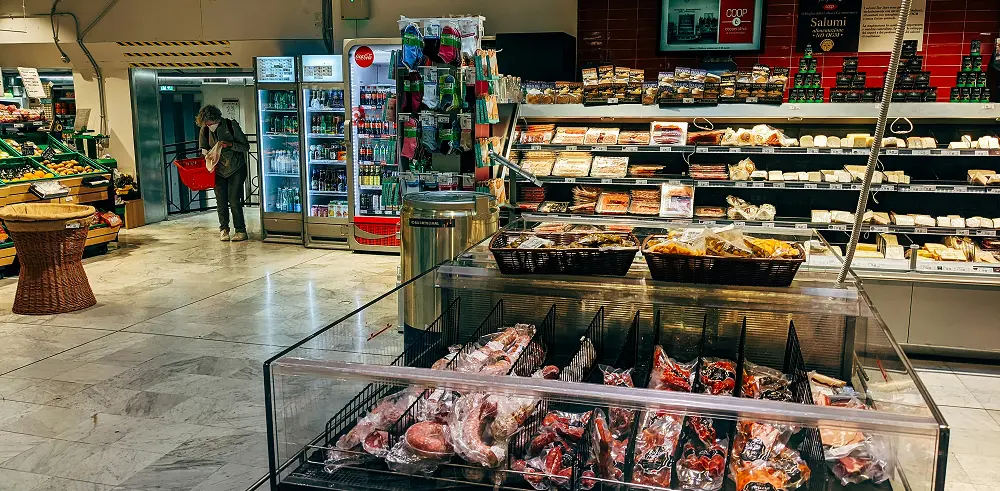
Cooling the Machine Inside the Silent War Between Data Centers and the Cold Chain
Table of Contents
ToggleThe Uncomfortable Truth About Food Security
Oracle and the Warning from the Server Room
Oracle’s October 2025 earnings revealed a quiet shock. Nine hundred million dollars in AI-server rentals produced only one hundred and twenty-five million in profit. Investors saw a technology stumble. In truth, it was a thermodynamic reckoning.
Three things triggered our investigation into this topic: first, Oracle’s earnings report; second, rising energy and refrigerant prices squeezing industries; and third, recent changes to EPA regulations affecting refrigerant management.
AI isn’t virtual: it’s physical. Every inference burns electricity, every watt of intelligence produces a watt of heat, and every degree of that heat must be moved somewhere else.
Oracle’s thin margin wasn’t an accounting error. It was the sound of metal, coolant, and electricity groaning under digital ambition.
Refrigerant Leak Detection and Regulatory Landscape: Navigating Federal Relaxations and State Requirements
As data centers expand rapidly to meet soaring demand for artificial intelligence and cloud computing, their physical systems increasingly rely on refrigerants that pose environmental risks if leaked.
While recent federal actions have temporarily relaxed certain refrigerant management standards to support critical infrastructure growth like data centers, these relaxations do not exempt facilities from complying with stringent state regulations.
States such as California, Washington, and New York maintain robust refrigerant management programs requiring rigorous leak detection, repair, and reporting protocols to protect air quality and public health.
California’s refrigerant management regulations enforce strict requirements on leak detectors and HVACR maintenance to identify and mitigate refrigerant leaks promptly.
Similarly, Washington State and New York emphasize continuous refrigerant monitoring and timely repairs to prevent harmful emissions. Measuring refrigerant levels and leakage rates is essential for ensuring compliance with these regulations and minimizing environmental impact.
An emerging consideration is data flows across state lines, particularly how AI data processed or stored in one state may trigger regulatory obligations in another.
For instance, California’s SB 219 mandates non-financial data reporting that could apply if data center operations (such as those involving cooling or refrigeration systems), even outside California, trigger reporting responsibilities and auditable documentation related to greenhouse gas emissions for entities with $500 million in sales.
Balancing efficient cooling with compliance to diverse federal and state regulations requires a proactive approach to refrigerant leak detection and facility management.
This ensures data centers support digital economy growth without compromising environmental stewardship or regulatory obligations.
🚨 Explore how smart leak detection keeps cooling efficient and sustainable
Cooling the Machine: Inside the Silent War Between Data Centers and the Cold Chain
While tech executives celebrate artificial intelligence’s revolutionary potential, a darker reality unfolds in the infrastructure powering our digital future.
Behind the gleaming hyperscale data centers and cloud computing promise lies an uncomfortable truth: cooling the machine inside the silent war between data centers and the cold chain is creating unprecedented competition for resources, making precise detection of leaks crucial.
This competition threatens the foundation of our food and medical supply systems. Data centers consume considerable land and resources, and each new facility takes significant land and infrastructure resources from the surrounding area, often with limited local employment benefits.
The rapid construction of these data centers brings significant environmental and infrastructural impacts, affecting local communities and ecosystems.
Between 2014 and 2024, energy demand from data centers surged by 300%, with cooling systems accounting for up to 40% of total power consumption.
The latest hyperscale data centers can use five times more energy than previous generations, highlighting the scale of their impact on electricity demand and infrastructure planning.
Data centers increasingly shape the dynamic nature of urban planning and infrastructure development, as they reshape the social, economic, and physical landscape of cities and towns. This explosive growth directly competes with cold chain infrastructure that keeps food fresh and medicines viable, raising concerns about refrigerant leaks.
Data centers compete for valuable kilowatts used to light homes, protect pharmaceuticals, and keep perishable foods safe. Millions in tax breaks and incentives attract data center projects, further fueling expansion.
Grocery stores are frontline casualties, facing energy price rises outpacing budgets. Refrigerants for cooling data centers and installed systems are in high demand.
These constrained resources are scarce everywhere, and data centers with deeper pockets outspend peers, leveraging future revenue opportunities unavailable to grocery operations.
Moreover, the shortage of skilled technicians is a national vulnerability, as both sectors compete for limited labor. Homeowners are left to bear increased energy costs through higher utility bills.

Two Systems, One Struggle: Grocers vs. Data Centers
Both grocery stores and data centers exist to prevent spoilage, one of food, the other of computation. Both rely on compressors, coils, and refrigerants. Yet only one faces stringent climate regulations.
Grocers must phase out high-GWP gases under the AIM Act: ≤ 1,400 by 2027, ≤ 150 by 2032, with tagging and leak detection system mandates.
Data centers, under the EPA’s September 2025 Technology Transitions Reconsideration, received exemptions above –30 °C.
Refrigerant leaks pose environmental and safety risks in both sectors, making effective leak detection and repair essential to prevent emissions and hazards. Leak detection system performance is evaluated on how quickly and accurately leaks are detected, ensuring compliance and minimizing environmental impact.
The result of effective leak detection and repair is improved safety, enhanced environmental protection, and greater operational efficiency.
EPA termed it “mission-critical reliability.” In practice, it was wartime privilege—an industrial exemption granted under national progress.
The same molecule (R-410A, R-134a) is treated as a pollutant in supermarkets and as a patriotic coolant in server rooms.

How Regulation Became a Weapon
Grocers retrofit, retrain, and report. Data centers expand freely, backed by trillion-dollar valuations. Regulatory asymmetry masquerades as innovation policy.
Food retailers are painted as emission risks to contain. Hyperscalers are celebrated as infrastructure to protect. One sector bends under compliance; the other cashes in on leniency.
Data centers have wartime-like privileges, allowing refrigerant choices otherwise phased out.
This exemption recognizes data centers’ critical national role but places responsibility on operators to balance operational needs with environmental stewardship; selecting refrigerants, optimizing performance and reliability while minimizing environmental impact, implementing robust leak detection systems, and ensuring timely repairs.
However, this latitude raises concerns about potential environmental risks if responsible refrigerant use is not rigorously enforced.
Data centers’ unique position (exempt from certain refrigerant limits yet subject to leak detection and repair mandates) creates a complex regulatory landscape demanding transparency, accountability, and proactive management.

The Material Arms Race: Fighting for the Same Molecules
A single hyperscaler recently sought 150 chillers @ 600 tons each, roughly 900,000 pounds of refrigerant, equal to charges in 300 supermarkets. Manufacturers divert capacity to giants; smaller buyers wait or overpay.
The primary product of data centers is digital services or data storage, which is consumed by users.
This product should be distinguished from the broader energy consumption and infrastructure demands required to power and cool these facilities.
The estimated refrigerant market size for the data center and cold chain sectors is projected to grow significantly over the next decade, reflecting increased cooling needs.
Industry stakeholders measure refrigerant usage and shortages using advanced monitoring and inventory tracking to manage supply constraints and anticipate shortages.
Changes in supply and demand dynamics can lead to shortages and price volatility, impacting both large and small buyers.
EPA’s allowance system (already 40% below baseline, heading to 85% by 2036) doesn’t expand to match demand. Every pound poured into a server hall is a pound unavailable to preserve food.
The refrigerant economy has become a proxy war for molecules, where capital, not necessity, decides who stays cool.
The Workforce Front: Technician Attrition as a National Vulnerability
The uncomfortable truth confronting the data center and cold chain industries reveals a fundamentally flawed foundation: the systematic neglect of skilled technician development has created a precarious workforce crisis that threatens the very infrastructure upon which our digital economy and essential supply chains depend.
The same technicians who keep milk cold now keep GPUs alive, drawn by higher pay, air-conditioned environments, and predictable hours in data centers.
Meanwhile, the grocery and HVAC sectors lose thousands of skilled hands yearly as leak-detection mandates tighten. This isn’t mere turnover; it’s a national resilience gap.
The complex orchestration of electrical systems, mechanical engineering, advanced IT protocols, and critical safety procedures demands nothing short of forensic precision—yet escalating attrition rates expose operational vulnerabilities across both sectors.
Without new pipelines of education programs like Stacks and Joules or community-college fast tracks, the country won’t have enough certified service people to serve either side of this war.
The industry’s belated embrace of digital twins and immersive training technologies represents an acknowledgment of systemic failure, yet these solutions remain prohibitively complex and financially inaccessible for smaller operators who cannot afford such sophistication.
The fundamental question remains whether these industries possess the institutional resolve to undertake the substantial investment in training, support, and innovation required to sustain our digital infrastructure and essential supply chains, or whether the endemic complacency that created this crisis will ultimately prove their undoing.

The Utility Front: Competing for Kilowatts
Electricity is scarce, political, and expensive. In Northern Virginia, data centers consume a quarter of total load, equivalent to hundreds of thousands of households.
Dominion Energy and Pepco filed 30%+ rate hikes to fund new substations; PJM’s capacity prices hit record highs, affecting energy distribution flow.
Utilities accommodating large data center loads may bear grid balancing and infrastructure funding responsibilities, raising questions about fair cost allocation among ratepayers.
Bloomberg’s 2025 analysis shows regional electricity up as much as 267% near hyperscale clusters.
Even households that never touched AI now pay its bill. Average D.C. customers: +$21/month, half tied directly to capacity surcharges.
This is energy inflation by proxy, a regressive tax disguised as modernization.
The Utility Paradigm: When the Grid Picks Sides
Utilities profit on capital investment, not efficiency. When a hyperscaler demands 500 MW, the utility builds, bills, and books guaranteed returns, costs socialized across the rate base.
We used to share a common grid; now, we subsidize a private industrial revolution. Hospitals can be curtailed during peak load; data centers cannot. Rural areas tend to welcome data centers despite challenges.
Grocers pay fuel riders inflated by AI demand while utilities collect risk-free yields.
The fix is simple but politically radioactive: Full-Cost Tariffs for Hyperscalers—make those triggering new capacity pay for it.

Refrigerant Inflation: The New Structural Spiral
Recent budget-ready forecasts for 2026+ show refrigerant prices rising sharply. A 2,500-pound supermarket leak (once $60,000) will soon exceed $180,000. Homeowner repairs could top $1,000 for a simple refrigerant charge.
These aren’t price spikes; they’re structural inflation baked into shrinking caps and scarce reclaim infrastructure. Data centers absorb it; grocers cannot.
The refrigerant market is becoming the 1970s oil market: volatile, financialized, and dominated by those who can stockpile.
The Ephemeral Bridge: Policy That Cancels Itself
The EPA’s proposed Technology Transition Adjustment enables interim limits meant as a bridge—but it’s a bridge built to collapse. Many groups celebrated the interim allowance, but supply limits remain; freedom to choose is a new robe for the emperor, as new data center growth strains supply.
By 2032, temporary clemency refrigerants will be outlawed. Today’s exemptions guarantee tomorrow’s stranded assets: billion-dollar chiller plants destined for premature obsolescence. Are data center investors aware of this impact?
The AIM Act’s countdown clock keeps ticking, even for those who believe they’re outside its reach. For those needing to efficiently track refrigerant assets as part of compliance, innovative tagging solutions are now available.
Environmental Irony: Selective Blindness
The AIM Act, signed in 2019, phases down hydrofluorocarbons (HFCs), powerful greenhouse gases used as refrigerants. It reflects bipartisan recognition of the need to reduce emissions and transition to climate-friendly alternatives.
Despite this, data centers enjoy selective regulatory leniency, escaping stringent refrigerant leak detection and repair requirements applied to sectors like grocery stores.
This disparity raises concerns about unchecked data center refrigerant leaks silently contributing to greenhouse gas emissions.
It underscores the need for comprehensive leak detection and transparent reporting across all sectors to ensure environmental stewardship amid digital expansion.
Grocers document every ounce leaked. Data centers leak quietly behind “mission-critical” halos.
Cultural Paradox: Applauding the Cloud While Starving the Cold Chain
We celebrate AI as the new frontier of progress, but neglect the machinery that keeps us alive.
Every new data hall christened as “innovation” pushes supermarkets into survival mode, forced to stretch thin margins against rising energy, people, materials, and refrigerant costs.
We marvel at machines that can think, while overlooking the ones that keep food cold, medicine stable, and communities fed.
In our race to build a smarter world, we’re quietly dismantling the systems that make it livable.
What are the consequences of prioritizing digital infrastructure over essential supply chains?
Prioritizing digital infrastructure, such as data centers, over essential supply chains like the cold chain leads to several critical consequences.
It creates intense competition for limited cooling resources (including energy, refrigerants, and skilled technicians), which can strain the capacity of food and pharmaceutical storage systems.
This competition results in increased operational costs for cold chain facilities and risks compromising the integrity of perishable goods and medicines due to insufficient cooling.
🚨 Prioritizing digital infrastructure over essential supply chains drives up cold chain costs and risks product integrity.
Contact us to safeguard your perishable goods and medicines.
Leak Detection: The Radar in a War for Cooling Resilience
In the Cold War for Cooling, leak detection is a radar that enables a possible truce.
SB 219 offers a reporting disclosure mandate for refrigerants, and as Data Centers trigger this obligation, the non-financial data requirements in California offer a possible view into the heart of operations and waste that could be trimmed to ensure the continued survival of the HVAC/R industry and our collective cooling needs.
For grocers, it’s a lifeline; sensors never sleep, alarms turn invisible losses into immediate action. Every leak caught saves money, ensures compliance, and avoids downtime. In an industry where margins are measured in degrees and ounces, leak detection is a survival instinct.
Advanced refrigerant leak detection technologies: sensors, alarms, like those provided by AKO, and continuous monitoring, like the LDAAS solutions delivered by Carbon Connector, are highly effective at identifying leaks quickly and accurately.
Leading companies in the leak detection and repair industry are driving innovation and setting industry trends, shaping how facilities approach refrigerant management.
Data centers remain behind. Shielded by exemptions and comforted by redundant systems, they rarely monitor refrigerant loss continuously.
Facilities running AI models sophisticated enough to forecast market crashes still rely on manual logs to spot gas leaks. Machine learning algorithms in modern leak detection systems can adjust their models to account for environmental changes, thereby improving detection accuracy and reducing false positives.

Yet this is the frontier both sides share: infrastructural longevity.
Refrigerants, skilled labor, and power are finite.
What remains scalable is visibility: the ability to detect loss before failure, especially in residential areas where cooling is critical.
Leak detection delivers that visibility, transforming environmental uncertainty into operational intelligence.
It offers each sector the same radar (the same accountability pulse) regardless of EPA favoritism or utility incentives.
→ For grocers, leak detection sustains viability.
→ For data centers, addressing issues such as the real cost of refrigerant leaks can sustain legitimacy.
With the right to operate beyond environmental boundaries comes the obligation to map material ones.
Leak detection isn’t bureaucracy. It’s reconnaissance: the quiet radar keeping both sides from flying blind into scarcity.
How can advanced leak detection technologies help address the challenges of refrigerant leaks in data centers and cold chain facilities?
Advanced leak detection technologies, such as the AKO Carbon Connector solution, provide continuous, real-time monitoring of refrigerant levels, enabling early detection of leaks before they escalate into costly failures or environmental hazards.
When combined with Leak Detection as a Service (LDAAS), operators gain an integrated platform that not only detects leaks but also offers actionable insights and analytics.
This proactive approach enhances operational efficiency, reduces downtime, and ensures compliance with stringent regulatory requirements, making it an essential tool for managing complex cooling infrastructures in both data centers and cold chain environments.
What role does Leak Detection as a Service (LDAAS) play in improving the effectiveness of leak detection systems for large-scale cooling operations?
LDAAS transforms traditional leak detection by offering a cloud-based, scalable service that aggregates sensor data, applies advanced analytics, and delivers timely alerts to facility managers and technicians.
Integrating LDAAS with the AKO/Carbon Connector solution creates a comprehensive ecosystem that enhances leak localization, minimizes false alarms, and supports continuous performance optimization.
This service model reduces the need for on-site resources, lowers operational costs, and provides a centralized platform for monitoring various scenarios across multiple facilities, ensuring optimal performance and environmental stewardship.
The Proxy War for Cooling
Server racks and grocery racks fight for the same electrons, technicians, and refrigerant molecules. EPA gave a one-sided exemption. Utilities gave it priority.
This is the Cold War for Cooling, a geopolitical struggle hidden inside domestic infrastructure. If refrigerant runs short or the grid buckles, both suffer. Owners should stay compliant with the AIM Act.
But one will go warm first, and it won’t be the servers.
→ For more information about how regulatory changes in refrigerants can impact your operations, see Navigating the EPA HFC Technology Transition Regulations.

What Happens Next? The Coming Reckoning
By 2032, the exemption window closes. Chillers installed today will face bans, scarcity, or astronomical service costs. Stay ahead in compliance.
Deep-pocketed buying freedom now will fund forced retrofits later. We watch a system rewired without consent, an industrial order built without public debate, its costs silently embedded in every utility bill.
What Each Side Can Do Now?
For Data Centers
- Track leaks now. Exemption isn’t immunity; adopt continuous detection and AFDD.
- Feed abnormal cooling system data into advanced leak detection algorithms: sensor data is fed into these models to improve early identification and response.
- Invest in maintenance futures. Break-fix culture collapses under scarcity.
- Fund training. You’re hiring from grocery refrigeration, help replace what you drain.
For Grocers
- Innovate locally. Hybrid CO₂ loops, reclaimed gas, and digital diagnostics keep margins alive.
- Seal and standardize. Use EPA reprieve to reduce leak rates and tag every asset.
- Budget early. Inflation is structural, not seasonal.

For Regulators and Utilities
→ Why SB 253 Compliance Starts With Refrigerant Leak Detection
→ Learn more about:
- Carbon Connector’s Leak Detection as a Service (LDaaS), a collaborative approach to smarter, insight-driven refrigerant leak detection,
- Its Benefits for compliance, safety, and operational performance,
- Our Refrigerant leak detection solutions.
The Radar and the Watch
We call it artificial intelligence, but there’s nothing artificial about the heat it gives off. The question is no longer who owns the data; it’s who keeps it cool.
Right now, the servers are winning the war for cold.
Leak detection is the radar that could level the field, and the rest of us pay for its absence in watts, refrigerant, and silence.
The Hands on the Radar
The radar is only as effective as the vigilant eyes and skilled hands monitoring it.
Across both grocery aisles and server rooms, the AKO Carbon Connector team acts as that quiet yet indispensable watch crew, developing advanced sensors, robust analytics, and field intelligence that empower both sectors to detect leaks early, before losses escalate into costly or environmentally damaging events.
Their approach is impartial, bridging the gap in this Silent War for Cooling without taking sides.
By translating raw data into actionable insights, they transform noise into meaningful signals and uncertainty into decisive action.
As we look toward a decade defined by resilience and sustainability, these hands-on radar guides grocers and data center operators alike toward enhanced visibility, operational discipline, and balanced resource management.
Because in the future of cooling, victory won’t belong to those consuming the most power, but to those who precisely know where every watt and molecule goes, ensuring optimal performance, reduced environmental impact, and sustained operational efficiency.

The Flawed Consensus on AI’s “Clean” Energy Revolution
The technology sector has crafted a narrative positioning data centers as catalysts for sustainable digital transformation.
This consensus crumbles under scrutiny when examining the actual infrastructure demands of cooling systems. While companies like Google and Microsoft tout renewable energy commitments, their cooling infrastructure expansion tells a different story.
Consider the scale: a single Tesla Giga Austin data center requires cooling towers handling over 10MW of heat load, with flow rates around 5,000 gallons per minute. Understanding cooling system data (flow rates, temperature fluctuations) is essential for optimizing performance and detecting anomalies.
These systems consume energy and compete directly with cold storage facilities, maintaining precise temperature controls for food and pharmaceuticals.
Evidence mounts. In regions where hyperscale data centers rapidly expand, food distribution centers report increased operational costs and reduced cooling capacity availability, exceeding national averages.
AI workloads requiring liquid and immersion cooling technologies exponentially increase pressure on shared cooling infrastructure.
The Silent Battleground: Power Grid Competition Between Digital and Physical Cold Chains
Competition for electrical power between data centers and cold chains is a critical front in this silent war.
Oregon exemplifies this: data centers consume 11.4% of the state’s energy, causing rolling blackouts disproportionately affecting refrigerated warehouses and food storage, exacerbated by environmental factors.
Power demand from AI and machine learning creates a new energy consumption category that utility companies struggle to accommodate alongside essential cold chain infrastructure.
Pressure sensors and monitoring systems for both sectors depend on consistent power, but utility priority increasingly favors tech infrastructure over food security.
Environmental impact extends beyond power. Data center regions show 50% higher carbon emissions per kWh, affecting food transportation networks and causing critical pressure fluctuations in cooling systems. Cold chain logistics operating in high-emission areas face compounded environmental costs.
Historical data from the past year reveals:
- Food storage facilities report 23% more power interruptions in high data center concentration areas
- Cold chain operational efficiency drops 18% during peak data center processing
- Utilities prioritize data center power allocation 3:1 over food storage needs
- Residential areas experience increased power instability, affecting home food preservation
Financial losses cascade through the food system. When refrigerated warehouses lose power, the priority is to data centers; temperature excursions cause massive food waste, underscoring the importance of monitoring potential leaks.
A four-hour power interruption at a major food distribution center can cause $2-3 million in spoiled inventory, which costs are passed to consumers.
The Path Forward: Accountability and Reassessment of Cooling Infrastructure Priorities
The assumption that digital transformation should supersede essential supply chain cooling requires immediate challenge.
Current infrastructure planning treats data centers and cold chains as separate entities competing for resources, rather than recognizing food security and medical supply integrity as essential public services needing protected cooling access.
Mandatory cooling impact assessments for new data center developments could be a crucial first step. These must be examined:
- Potential strain on local food storage and pharmaceutical facilities
- Long-term effects on food security and medical supply reliability
- Alternative cooling technologies minimize resource competition
- Shared infrastructure solutions benefiting both sectors
Transparent resource allocation must prioritize food security over computational convenience. This doesn’t halt data center development but requires tech companies to invest in cooling solutions that don’t compromise essential supply chains.
Technologies like repurposed oil and gas pipelines for cooling, advanced leak detection for shared cooling systems, and hybrid cooling approaches reduce competition for traditional cooling resources.
It is also necessary to explore new approaches and solutions, such as advanced digital twin models and shared infrastructure planning, to further optimize cooling resource allocation and minimize competition for a sustainable future.

Integrated cooling infrastructure planning offers the most promising path forward. Recent frameworks for shared resource management between data centers and cold chains emphasize protocols ensuring equitable access and efficient cooling allocation.
Regional planning must account for the cooling needs of both digital and physical cold chains, including:
- Reserved cooling capacity quotas for food and pharmaceutical storage
- Shared cooling infrastructure with guaranteed access protocols
- Investment requirements for data centers contributing to regional cooling capacity
- Performance monitoring, preventing cooling monopolization
Location-based cooling resource management ensures essential supply chain operations maintain priority cooling access. While data processing can be distributed globally, food storage and pharmaceutical distribution must remain tied to local communities.
Effective leak detection and financial validation measures, such as those described in How FASB 818 Brings Financial Rigor to Environmental Credits, further support responsible and accountable cooling management.
The Mandate for Change: Can Tech Giants Meet Social Responsibility Standards?
Examining major tech companies reveals a troubling gap between public commitments and infrastructure reality. Google, Microsoft, and Amazon promote environmental initiatives and energy efficiency, but their cooling infrastructure expansion rates far exceed efficiency gains.
Google’s carbon neutrality commitment by 2030 sounds impressive until examined against data center cooling demands.
While Google improved cooling efficiency by 15% recently, total cooling infrastructure expanded by 250%, increasing competition for cooling resources despite efficiency gains.
Microsoft’s underwater data center experiments demonstrate the lengths companies go to avoid competing for land-based cooling, but terrestrial data centers continue monopolizing traditional cooling resources.
Amazon’s logistics network depends heavily on cold chains for food and pharmaceuticals, but competes internally for cooling resources, creating conflicts between business units.
Industry self-regulation has struggled to address cooling resource competition. Voluntary efficiency programs and sustainability commitments lag behind expansion rates, increasing cooling infrastructure pressure.
Diverse cooling technologies (from air to immersion cooling) offer innovation opportunities that don’t compete with essential supply chains.
Mandatory cooling capacity sharing agreements between data centers and cold chains offer viable solutions, particularly as refrigerant leak detection becomes increasingly important in the context of rising tariffs and regulatory changes. These require data centers to:
- Invest in cooling infrastructure benefiting local food and pharmaceutical storage
- Share cooling capacity during non-peak periods
- Contribute to backup cooling systems for essential supply chains
- Submit to monitoring, preventing cooling monopolization
Regulatory frameworks must address the fundamental imbalance between data center profitability and essential supply chain protection.
📌 When cooling infrastructure becomes zero-sum, public interest demands prioritizing food security and medical integrity over computational convenience.
The Unavoidable Truth: The Cost of Digital Prioritization
The conflict between AI’s cooling demands and food security infrastructure is more than engineering; it’s a societal choice with profound consequences.
Cooling the machine inside the silent war between data centers and the cold chain isn’t just competing technologies; it’s prioritizing digital convenience over essential human needs.
Policymakers, industry leaders, and communities face an undeniable reality: every new hyperscale data center monopolizing cooling infrastructure threatens local food security and medical supply reliability.
Evidence (from Oregon’s power strain to pharmaceutical cold storage failures) shows competition has moved beyond theory into measurable harm.

Allowing tech industry cooling demands to undermine food and medical distribution has consequences beyond costs and efficiency.
When cooling competition forces food storage relocation or pharmaceutical temperature compromises, communities lose essential services that no digital convenience can replace.
The crisis poses a fundamental question: Is our digital future worth risking physical supply chains sustaining human life?
The past year’s evidence shows that current cooling infrastructure approaches create unacceptable food security and medical supply risks.
The path forward requires acknowledging that cooling the machine cannot come at the expense of cooling essentials.
Data centers and cold chains both serve vital functions, but when forced into resource competition, essential supply chains must receive priority protection.
🚨 Invest in advanced detection technologies to identify and mitigate emissions quickly, lowering environmental impact and operational costs.
Global Implications and Cooperation: The World’s Stake in the Cooling Conflict
Cooling resource competition transcends borders. As data centers and cloud facilities proliferate globally, their energy demand and environmental impact are worldwide concerns.
International cooperation is essential to address complex, interconnected challenges. Adoption of digital twin technology and advanced solutions can reduce energy demand and improve efficiency across facilities.
Realizing benefits requires collaboration; sharing knowledge, setting standards, and coordinating infrastructure and innovation investments. Ongoing research plays a critical role in developing sustainable cooling technologies and strategies worldwide, ensuring solutions rest on the latest science and technology.
By working together, governments, companies, and organizations can develop strategies addressing regional needs while advancing global sustainability goals.
This means tackling leak detection, energy supply, and operational efficiency challenges, while exploring ways to support economic development and social well-being.
In an increasingly digital world, the cooling conflict concerns us all. Choices today (about technology, policy, and cooperation) will determine if we build a resilient, equitable, and sustainable future for all.
Data Center Infrastructure: The Hidden Backbone of the Digital Age
Behind every click, stream, and cloud-based service lies an uncomfortable truth: a vast, systematically concealed network of data centers that the digital economy desperately wants you to ignore.
These facilities, categorized into hyperscale, enterprise, and edge operations, represent a fundamentally flawed approach to sustainable technology.
The industry’s claims about efficiency face significant challenges when confronted with hyperscale data centers engineered for relentless scalability, supporting millions of users and petabytes of data while adopting immersion cooling systems; not solely for innovation, but also to manage their substantial energy demands and operational costs.
The figures tell a different story from the tech industry’s carefully crafted narrative. The US Department of Energy’s forensic analysis reveals that data centers now devour approximately 4.4% of the nation’s total electricity consumption, a staggering indictment of our digital infrastructure’s systemic energy use.
These facilities operate with meticulously designed uptime protocols and robust security measures, yet their advanced cooling systems and redundant power supplies represent mechanisms with considerable environmental impact.
The uncomfortable reality is that as digital infrastructure expands inexorably, the operational costs associated with cooling and maintaining these systems have become the defining crisis, not merely for complacent tech companies, but for an economy and environment held hostage by unchecked digital consumption.
The sheer scale and energy appetite of these categorized facilities make them the focal point of a sustainability reckoning that the industry can no longer evade through hollow innovation promises and greenwashing rhetoric.

Two Buckets One Well: Grocers vs. Data Centers
The uncomfortable truth about data centers and grocers reveals a systemic crisis in modern resource allocation that industry leaders struggle to address. Both infrastructures depend on identical networks (roads, water, energy), yet their fundamentally flawed priorities create precarious trade-offs that expose the challenges of current resource management.
Data centers demand vast quantities of water and fluid for cooling, inevitably resulting in leaks that represent not merely operational inefficiency but a damning indictment of an industry grappling with resource wastage. Meanwhile, grocers rely on logistics networks and infrastructure stability to deliver perishable goods, creating an inevitable collision course with data center demands.
The critical question remains: how long can we ignore this unsustainable competition?
The mandate for digital twins emerges not as a convenient technological solution but as an accountability mechanism that exposes the inadequacy of current monitoring systems.
By leveraging historical data and sophisticated algorithms, digital twins can detect leaks, predict failures, and optimize performance in real time; capabilities that should be incumbent upon any responsible infrastructure operator.
A forensic analysis reveals that a digital twin of a data center’s cooling system can identify fluid loss before it becomes critical, while grocery supply chain twins can flag transportation bottlenecks or refrigeration anomalies that current systems systematically ignore.
However, implementing these systems demands confronting the uncomfortable reality of energy demand, water usage, and operational costs that the industry has long evaded.
The struggle between these systems transcends mere technology; it requires a fundamental reassessment of resource allocation, an unflinching examination of trade-offs, and an immediate commitment to ensuring both digital and physical supply chains demonstrate resilience rather than the current precarious dependency on inadequate monitoring.
The Material Arms Race: Fighting for the Same Molecules
The unsustainable expansion of data centers has precipitated a fundamentally flawed material competition, with industries from semiconductors to oil and gas engaged in a precarious struggle for identical critical resources.
Rare earth metals, essential for both advanced computing and renewable energy technologies, face unprecedented demand; a reality that exposes the significant challenges underlying our supply chain strategies.
The figures tell a different story than industry rhetoric suggests: the oil and gas sector’s parallel pursuit of these materials has created systemic vulnerabilities that render current pricing models and availability projections entirely inadequate.
Digital twin technology, while heralded as the definitive solution, demands rigorous scrutiny of its actual capabilities versus the inflated claims. But let us be clear: analyzing historical data and deploying advanced algorithms represents only the foundation of what these systems must accomplish.
The uncomfortable reality is that detecting inefficiencies and predicting shortages requires a level of data integration that few organizations have achieved.
A digital twin monitoring material flows through supply chains may indeed identify anomalies signaling impending shortages, but the critical question remains whether industries possess the institutional resolve to act upon these warnings.
The systemic complexity and the staggering volume of data required expose fundamental implementation barriers that the technology sector has been reluctant to acknowledge.
As global interconnectedness intensifies, the capacity to detect and respond to material constraints will inevitably determine which organizations survive the coming resource crisis, yet the current trajectory suggests that most remain perilously unprepared for this harsh reckoning.

The Workforce Front: Technician Attrition as National Vulnerability
The uncomfortable truth confronting the data center industry reveals a fundamentally flawed foundation: the systematic neglect of skilled technician development has created a precarious workforce crisis that threatens the very infrastructure upon which our digital economy depends.
The complex orchestration of electrical systems, mechanical engineering, advanced IT protocols, and critical safety procedures demands nothing short of forensic precision, yet the industry’s challenges in workforce development have produced inevitable consequences in the form of escalating attrition rates that expose the sector’s operational vulnerability.
The industry’s belated embrace of digital twins and immersive training technologies represents an acknowledgment of systemic failure, yet these solutions remain prohibitively complex and financially inaccessible for smaller operators who cannot afford such technological sophistication.
We must confront the stark reality that high-voltage equipment, heavy machinery, and hazardous materials present uncompromising risks that demand unwavering professional competence; risks that the current workforce crisis has rendered alarmingly acute.
The fundamental question remains whether this industry possesses the institutional resolve to undertake the substantial investment in training, support, and innovation required to sustain our digital infrastructure, or whether the endemic complacency that created this crisis will ultimately prove its undoing.




